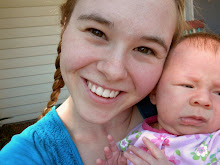What is more fun than an enormous, creepy-crawly-cute ladybug? This pacifier clip is perfect for either baby girls or boys, and knits up in only a few hours. Although the skills involved are pretty basic, it does take a good eye to put this fuzzy insect together, so keep in mind this is an intermediate-level project.
Materials:
- Small amounts of yarn in red, green, black and cream. Red should be sock or dk weight, green, black and cream work better with worsted weight yarn.
- One suspender clip, ¾ in. size. These are available from http://www.etsy.com/shop/PacifierClipSupplies
- 1 small (1 cm. – ¼ in.) green button
Tools:
- Set of three double-pointed needles, US Size 3
- Yarn needle
- Scissors
Row 1-2: knit
Row 3: k3, pass 2nd stitch over 3rd, k1, pass 2nd stitch over 4th. 2 stitches remain with a hole of two stitches.
Row 4: k1, m2, k1. You have just formed the button hole!
Knit even until piece measures 2 inches.
Next row: k1, k2tog, k1. 3 stitches remain. Do not turn. Work across these three stitches to form I-cord.
Knit I-cord for 9 inches.
Increase to attach pacifier clip: k1, (m1, k1) 2 times. 5 stitches.
If yarn is very lightweight, work one more row k1, m1, k3, m1, k1. 7 stitches.
Cut yarn, leaving tail of 6 inches. Thread tail through yarn needle and securely sew live stitches to the clip using a figure-eight motion. Tie off in back of clip, and pull remaining yarn up through the stem to hide the tail.
Make Ladybug:
Row 1: On each needle, k1, (m1, k1)x2. 10 stitches total.
Row 2 and all even rows: knit
Row 3: On each needle, k1, (m1, k1)x4. 18 stitches total.
Row 5: On each needle, k2, m1, k3, m1, k2, m1, k2. 24 stitches total
Rows 6-12: knit
Row 13: On each needle (k2, k2 tog)x3
Row 14: knit
Row 15: On each needle (k1, k2tog)x3. Cut red yarn
Loosely wind spare yarn (red or black) around two fingers approx 15 times to create stuffing for ladybug. Cut yarn and stuff body.
Row 16: With black, knit all 12 stitches.
Row 17: On each needle, k1, ssk, k2tog, k1
Row 18: knit
Row 19: On each needle, ssk, k2tog
Cut yarn with ~36 in long tail and graft stitches together with kitchener stitch.
Embroidery:
Draw long tail from grafting stitches into the ladybug head, come out in middle back of bug. Form a straight line down to the end of the shell.
Spots: Embroider spots with French knots, following pattern of ladybugs. I made a 13-spotted ladybug in the sequence of 2:4:4:3, but you can make any pattern you’d like.
Antennae: Draw yarn out to left front of head and back around 1 stitch to create a loop. Hand-chain 5 stitches tightly to create antennae, loop yarn three times through last loop and pull tightly. With needle, thread tail down through chained stitches and back into head. Repeat on the right front side of head.
Legs: Make six legs in the same manner as antennae. Front legs are placed right at the join between red and black, chaining 7 stitches long. Middle legs are 9 stitches long. Back legs are 12 stitches long, and point to the back instead of front.
Face: With white, embroider pattern on thorax (black part of body), following photos.
With the stem, form a loop and position ladybug on loop. Sew tips of legs to the stem, the two front right legs to the loop, the back left leg to the bottom of the stem, and the top left leg to the top of the stem if needed. The key with positioning the ladybug is to make sure you don’t twist the stem. Hold the pacifier clip up to check that the clip hangs straight. Sew the stem down to the middle of the body of the ladybug.











3 comments:
So amazingly fabulous! Especially the lady bug clip model. Kisses and hugs to you, sweet little baby model.
I just found your pattern and i love it! However I got a little confused around row 5, is it k2, mi, k2?
I also used the pattern to make a blue beetle instead of a lady bug, didnt think you'd mind.
In row 5 you are increasing from 9 stitches on each needle (18 total) to 12 stitches on each needle (24 total). Thus you need to increase 3 spread evenly across each needle. It would be nicer if it worked out to be K2, m1 across, but it doesn't work numerically since 9 is an odd number. Does that make sense?
I'd love to see pictures of your blue beetle!
Post a Comment